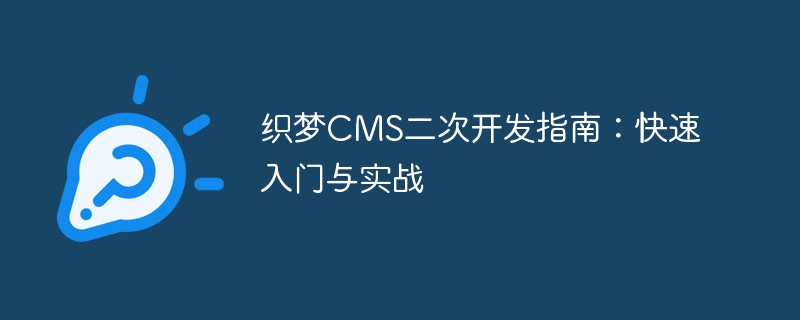Home >Backend Development >PHP Tutorial >DreamWeaver CMS Secondary Development Guide: Quick Start and Practical Combat
DreamWeaver CMS Secondary Development Guide: Quick Start and Practical Combat
- PHPzOriginal
- 2024-03-28 11:15:04953browse

[Dreamweaver CMS Secondary Development Guide: Quick Start and Practical Combat]
As a well-known open source website construction system in China, Dreamweaver CMS has a long history in the field of website construction. Wide range of applications. Its rich functional modules and friendly operation interface are loved by many website developers. However, sometimes we need to carry out secondary development of DreamWeaver CMS according to specific needs to meet personalized needs. This article will introduce the introductory guide to the secondary development of Dreamweaver CMS, and give specific code examples through practical cases to help readers quickly master the secondary development technology of Dreamweaver CMS.
1. Introduction to the secondary development of Dreamweaver CMS
1. Environment setup
Before carrying out the secondary development of Dreamweaver CMS, you first need to set up a good development environment. Make sure your server environment supports PHP and MySQL, and the Dreamweaver CMS system is installed. You can download the latest DreamWeaver CMS installation package from the official website and install it according to the official documentation.
2. Third-party tools
In order to facilitate secondary development, you can use some third-party tools, such as the editor Sublime Text, the development tool XAMPP, etc. These tools can improve development efficiency and make development more convenient.
3. Study documents and manuals
Being familiar with the official documents and manuals of Dreamweaver CMS is an important basis for secondary development. The document contains detailed information about the system's various functional modules, API interfaces, etc., which can help you better understand the working principle and implementation of the system.
2. Practical practice of secondary development of Dreamweaver CMS
1. Customized template
Although the default template of Dreamweaver CMS is fully functional, sometimes we need to customize it according to the needs of the website. Customized design. Through secondary development, we can create custom templates to achieve personalized customization of page style and layout. The following is a simple sample code for creating a custom template:
<?php
if(!defined('IN_EMLOG')) {
exit('error!');
}
include View::getView('header');
?>
<div id="content" class="main">
<h2 class="title">自定义模板示例</h2>
<div class="post-content">
// 这里是自定义模板的内容
</div>
</div>
<?php
include View::getView('footer');
?>2. Plug-in development
In addition to custom templates, Dreamweaver CMS also supports the development and extension of plug-ins. By developing plug-ins, various new functions can be added to the website, such as SEO optimization, social sharing, etc. The following is a simple plug-in sample code to implement the article reading statistics function:
function plugin_setting_view() {
echo '<p>该插件用于统计文章的阅读量</p>';
}
function show_read_count($logData) {
$logid = $logData['logid'];
$views = $logData['views'];
$views = $views + 1;
db_alter("update".DB_PREFIX."blog set views=views+1 where gid=".$logid);
return $views;
}3. Database operation
In the secondary development process, we may need to directly operate the database to achieve certain features. Dreamweaver CMS encapsulates some database operation functions, such as query(), insert(), update(), etc. The following is a simple database operation sample code for querying the article list:
$logs = array();
$query = $DB->query("SELECT * FROM ".DB_PREFIX."blog ORDER BY date DESC LIMIT 10");
while ($row = $DB->fetch_array($query)) {
$logs[] = $row;
}Conclusion
Through the above examples, we briefly introduced the secondary development entry and practical experience of DreamWeaver CMS. When conducting secondary development, attention should be paid to ensuring the security and maintainability of the code, following standardized development processes, and avoiding damaging the original functions of the system. I hope this article will be helpful to you, and I wish you smooth progress in the secondary development of DreamWeaver CMS!
The above is the detailed content of DreamWeaver CMS Secondary Development Guide: Quick Start and Practical Combat. For more information, please follow other related articles on the PHP Chinese website!

